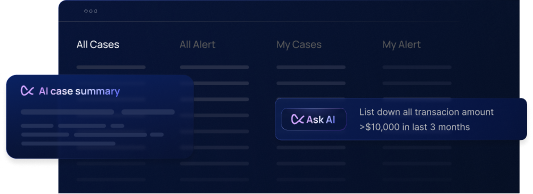A subtle shift is happening in credit union compliance offices. Examiners now expect suspicious activity to be detected and logged as it happens, not hours or days later. This anecdote reflects a broader trend across the industry: “batch is dead.” Credit unions that have long relied on next-day batch processing for AML alerts are being challenged to embrace real-time monitoring. Below, we’ll explore why regulators have moved on from batch alerting, how recent NCUA guidance is raising the bar, and how Flagright’s real-time AML platform is purpose-built to meet these evolving expectations.
The End of Overnight Batch Monitoring (And Why It’s Overdue)
Batch-based transaction monitoring systems, which aggregate and review transactions in nightly or periodic batches, were once the norm. They served their purpose in a slower banking era, but their limitations have become glaring in today’s always-on financial landscape. With instant payment rails and digital channels, suspicious transactions can move across the globe in seconds. An alert generated 24 hours after the fact is often 24 hours too late. Criminals have learned to exploit these delays. For example, a fraudster might initiate a series of illicit transfers at 5:00 PM, knowing a credit union’s legacy system won’t flag the activity until an overnight batch job runs – by which time the money is long gone.
Regulators have taken notice. There’s a growing consensus that timeliness is critical to an effective AML program. If a credit union isn’t catching red flags until the next day, it risks both missing the chance to intervene and filing delayed Suspicious Activity Reports (SARs). Bank Secrecy Act regulations already mandate prompt SAR filing, and that implicitly requires prompt detection. In the age of real-time payments, “good enough” transaction monitoring isn’t good enough anymore.
Regulators Raise the Bar: NCUA Guidance Signals Real-Time Expectations
This shift from batch to real-time isn’t just a theoretical best practice, it’s being driven by examiners on the ground. The NCUA’s recent guidance and examiner behavior show a clear emphasis on faster, more proactive AML compliance. In fact, NCUA’s 2024 Supervisory Priorities explicitly call out that BSA compliance remains a top focus, and the agency has pledged to update “supervisory expectations and examination procedures” for BSA/AML programs. In plain terms, credit unions should prepare for tougher questions on the effectiveness and timeliness of their transaction monitoring.
Field reports from late 2023 and early 2024 indicate examiners are indeed paying renewed attention to BSA/AML controls, even though it wasn’t highlighted in the prior year’s written priorities. One likely catalyst was a high-profile enforcement case: in January 2023, FinCEN levied a $100,000 civil penalty against a credit union’s BSA officer for egregious compliance failures, accusing the individual of allowing millions in suspicious deposits (including into his own money services business) to go unreported. It’s exceptionally rare for regulators to fine a credit union staffer personally, a strong signal that complacency in BSA/AML won’t be tolerated. NCUA examiners got the message. They are now scrutinizing whether credit unions have the tools and processes to catch illicit activity in real time, not months after the fact. As one 2024 compliance bulletin put it, BSA/AML has “made a comeback” in examiner focus.
Critically, “real-time” is no longer just a buzzword – it’s becoming an expectation. Examiners have started asking for evidence of real-time monitoring, such as alert logs with timestamps to show how quickly suspicious transactions surface and how promptly staff investigate them. Credit unions that still rely solely on batch alerts may find themselves at pains to justify why an alert on an 8:00 AM wire transfer didn’t hit the queue until the following day’s morning report. In the eyes of regulators, those lost hours could mean lost money or missed opportunities to file timely reports to law enforcement.
The NCUA’s stance aligns with broader regulatory trends. Federal banking regulators and FinCEN have been encouraging “technological innovation” in AML for a few years now. The Anti-Money Laundering Act of 2020 explicitly calls on financial institutions to modernize their AML programs and “adapt…to new and emerging threats” by adopting new technologies. In a joint statement, the NCUA and fellow agencies welcomed innovative approaches, such as artificial intelligence and real-time analytics – noting that such technologies can “strengthen BSA/AML compliance” and “enhance transaction monitoring systems.” In other words, regulators are not only okay with credit unions moving beyond batch; they expect them to. The agencies have even promised that trying new compliance tech (through pilot programs, etc.) will not automatically draw criticism, as long as institutions still meet their basic obligations. This is a green light to invest in better systems.
NCUA leadership has also hinted at this shift in focus. In a 2023 speech, NCUA Chairman Todd Harper spoke about the advent of instant payments (like FedNow) and warned that faster settlement comes with heightened fraud risks. “Real-time payments are both the present and future of financial services,” Harper noted, adding that because transactions are irrevocable, they “present an enticing opportunity for fraudsters” – making it vital for institutions to “prioritize instant payments security by applying sound anti-fraud measures.” While his comments were aimed at fraud and cybersecurity, the implication for AML is clear: if money moves in real time, monitoring must also happen in real time. A compliance program stuck in batch mode is out of step with how financial crime occurs today.
Why Batch Alerting Falls Short in 2025’s Risk Environment
To truly understand why examiners are insistent on real-time capabilities, consider how the risk landscape has evolved. Just a decade ago, daily batch monitoring might have been sufficient for a typical community credit union. Transactions posted in batches (e.g. ACH files, batch card settlements) and suspicious patterns could be reviewed after the fact without much damage done. Today, however, the ecosystem is radically different:
- 24/7 Transactions: Members can send money instantly using P2P apps, online transfers, or emerging networks like RTP and FedNow that clear payments in seconds. Fraudulent funds can be withdrawn or retransferred multiple times before a traditional batch system would ever flag the initial transaction. By the time a batch alert fires, the trail is cold.
- Faster Fraud Schemes: Criminals operate on internet time. Whether it’s an account takeover, an elder financial abuse scam, or a money mule scheme, bad actors often try to accomplish their goals in a single session. They count on delays in monitoring. If your system isn’t watching in the moment, you’re effectively giving fraudsters a free runway.
- Higher Alert Volumes: Ironically, batch systems often generate more alerts overall – but with less fidelity. They lack context of events happening between batch runs, which can lead to duplicated or redundant alerts once the batch finally processes. Compliance teams then face a next-morning pile of alerts to sift through, increasing the chance of something important slipping through or being addressed too slowly.
- Intervention Opportunities: Perhaps the biggest practical drawback of batch monitoring is the lost chance to intervene. Real-time alerts open the door to real-time action – freezing an account, blocking a suspicious wire, or conducting enhanced due diligence before letting funds go. With batch detection, the suspicious transaction is long gone. At best, the credit union can file a SAR after the fact; at worst, members’ money or the institution’s own funds could be at risk in the interim.
From a regulator’s perspective, these limitations translate into safety and soundness concerns. NCUA’s mandate is to protect the credit union system and its members. A credit union that cannot quickly detect and react to illicit activity may incur losses (credit, fraud, legal) or facilitate criminal behavior, undermining confidence in the institution. This is why NCUA examiners are increasingly probing how quickly a credit union’s AML system identifies issues. They are essentially asking: “If something bad happens at 2:47 PM on a Tuesday, will your system catch it by 2:48 PM… or not until the next day?”
In practical terms, batch alerting is starting to be seen as a governance issue. A lagging monitoring system could be viewed as a weakness in the credit union’s risk management framework. Under the CAMELS rating system, for instance, weak BSA/AML controls can factor into the “Management” or “Sensitivity to risk” components. And as noted earlier, severe AML lapses can even threaten an institution’s existence, no credit union wants to be the one that “shuttered” due to a BSA scandal. That specter is pushing compliance executives to reconsider their technology.
The Flagright Solution: Real-Time AML Compliance Without the Bloat
Flagright’s unified AML compliance software delivers real-time, API-driven monitoring and investigation tools, including a no-code scenario builder, instant alerting, case management, screening, and AI Forensics—all designed to meet modern examiner expectations.
So what does a real-time AML stack look like in practice? Flagright’s platform is composed of several tightly-integrated components that together replace the need for batch processing:
- High-Performance Scenario Builder: At the heart is a no-code rules engine where compliance teams can define monitoring scenarios (for fraud, money laundering typologies, suspicious patterns) and risk scoring models. Unlike older systems that might recalculate rules overnight, Flagright’s scenario engine evaluates transactions in real-time. A sub-second API ensures that the rules screen each transaction hitting the core banking system, card network, or payment app within milliseconds, not hours. This means alerts are triggered immediately the transaction happens. Flagright’s cloud-native infrastructure ensures even high volumes of transactions are processed continuously without slowing down customer-facing systems.
- Real-Time Alerts & API Integration: Flagright provides alerts via dashboards and can also feed them into the credit union’s workflows through APIs or webhooks. For example, if a Flagright rule flags a potential structuring attempt, the system can instantly push an alert to a case officer’s queue and (if configured) send a message to the banking platform to hold the transaction for review. This kind of seamless integration allows for automated intervention. Crucially, it also generates the “alert logs” that examiners are asking for – rich with timestamps and data showing exactly when an alert was generated and what follow-up occurred.
- Case Management & Investigation Tools: Instead of dumping alerts into spreadsheets or a disparate case management tool, Flagright includes built-in case management. Each alert can automatically create a case, pull in relevant customer/account data, and even suggest risk insights. Investigators have a one-stop interface to triage and resolve alerts. This eliminates the lag time in manually gathering info after an alert triggers. By streamlining the investigative step, Flagright helps ensure a real-time alert leads to a near-real-time response. (After all, an alert that sits untouched for days is not much better than a slow batch alert.)
- AI Forensics and Analytics: A standout feature of Flagright’s platform is the AI Forensics module – essentially specialized AI agents that assist with compliance challenges. For transaction monitoring, AI Forensics can automatically cross-reference an alerted transaction with patterns learned from past fraud/Ml cases or external data (like adverse media or watchlists). It can also draft narrative reports for SAR filing or identify linked transactions that the scenario’s rule logic might not explicitly catch. This AI layer augments the compliance team, helping them dig deeper faster. In a world where examiners are increasingly savvy (sometimes asking about things like machine learning or anomaly detection), being able to show an AI-augmented monitoring process is a plus. Regulators have stated that such innovation can “maximize utilization of… compliance resources” – exactly what Flagright’s AI forensic tools aim to do.
- Sanctions Screening and Risk Scoring: Alongside transaction rules, Flagright offers real-time screening (e.g. OFAC, sanction lists, PEP databases) and dynamic risk scoring for customers. This means a credit union can consolidate multiple compliance processes on one platform. For instance, if a member’s risk score suddenly spikes due to unusual activity, the system can factor that into transaction monitoring in real time (perhaps lowering thresholds for that individual). All of this happens without heavy manual intervention, thanks to automation and API connectivity.
Importantly, Flagright delivers these capabilities without the “bloated” integrations or exorbitant costs associated with traditional AML software. The platform is API-first and cloud-based, which has two key benefits for credit unions: speedy deployment and lower total cost. There’s no need for months of custom IT projects to get up and running. In fact, some Flagright customers have gone live in a matter of weeks, not months, not quarters – a critical factor for credit unions that don’t have big-tech budgets or staffs. And because it’s no-code, the compliance team (not just IT) can adjust scenarios or create new rules on the fly to adapt to emerging risks, without paying professional services fees for every tweak. This agility is something examiners appreciate; it demonstrates a “risk-based approach” where the institution can quickly respond to new threats (as intended by the AML Act and proposed AML/CFT rules).
To put it simply, Flagright’s real-time AML stack gives credit unions the firepower of a cutting-edge compliance program, but in a turnkey package. It’s as if you could plug a “compliance brain” directly into your transaction stream that watches every movement of funds with unblinking attention. For a BSA officer, this not only means better crime detection – it means being able to walk into an NCUA exam and confidently demonstrate that your monitoring is up to the minute. You can show examiners a live system, perhaps even generate a test alert in front of them by inputting a dummy suspicious transaction, and point to logs that prove no alerts are sitting unseen for days. It turns what used to be a vulnerability (“Our system only updates once daily”) into a strength (“We have continuous monitoring, as recommended by regulators”). Little wonder that more credit unions are now phasing out legacy batch systems in favor of platforms like Flagright.
Embracing the Real-Time Future
It’s time to declare the end of batch processing not just as a technological upgrade, but as a cultural shift in compliance. Credit unions that embrace real-time monitoring are positioning themselves to stay ahead of both criminals and examiners. They are sending a message: We take financial crime seriously enough to fight it in the moment, not after the fact. This proactive stance will only become more important as financial services continue to speed up and digitize. In the words of Flagright’s Baran Özkan, “Compliance can’t be an afterthought – it has to keep pace with innovation. Real-time isn’t a luxury anymore; it’s a necessity.”
For credit union risk and compliance professionals, the writing is on the wall. If your next NCUA examiner asks for real-time alert logs, will you have them? If the answer is uncertain, now is the time to assess your readiness for real-time monitoring. Transitioning from batch to real-time AML may sound daunting, but with modern solutions available (and regulatory encouragement to adopt them), it’s more achievable than ever – and arguably more cost-effective than managing the fallout of a major compliance issue.
In the end, the shift to real-time monitoring is about protecting what matters most: your members, your institution, and the integrity of the financial system. Batch is dead; long live real-time AML. It’s the future of compliance – and the future is now.




.svg)





















